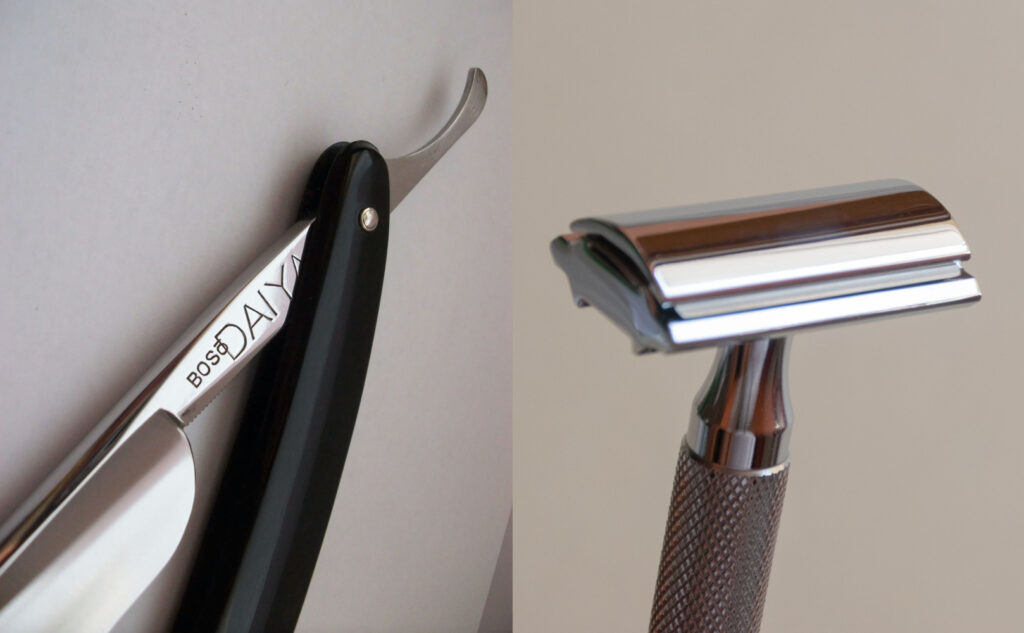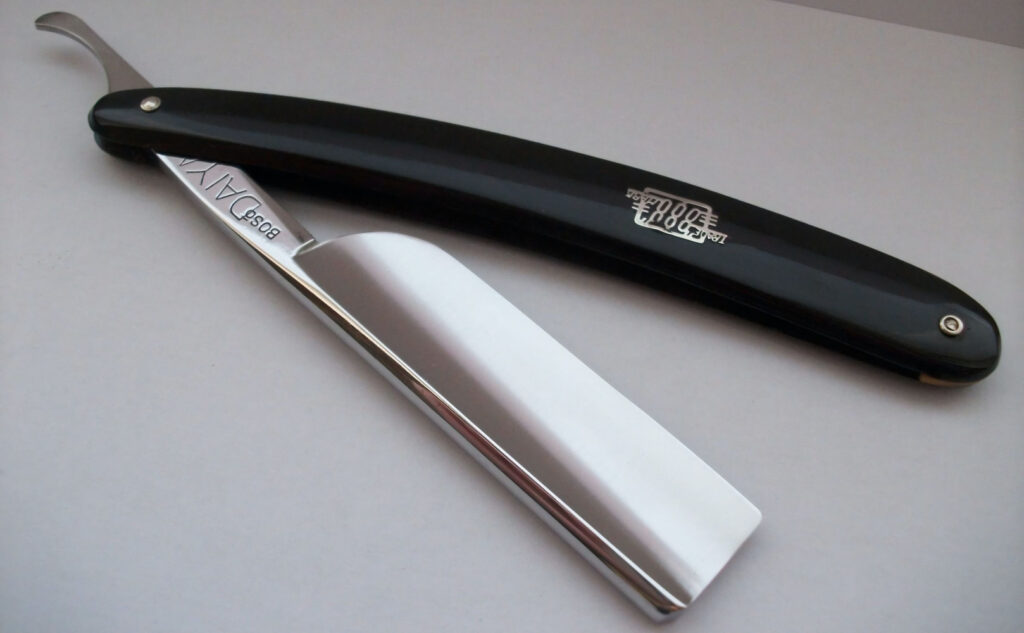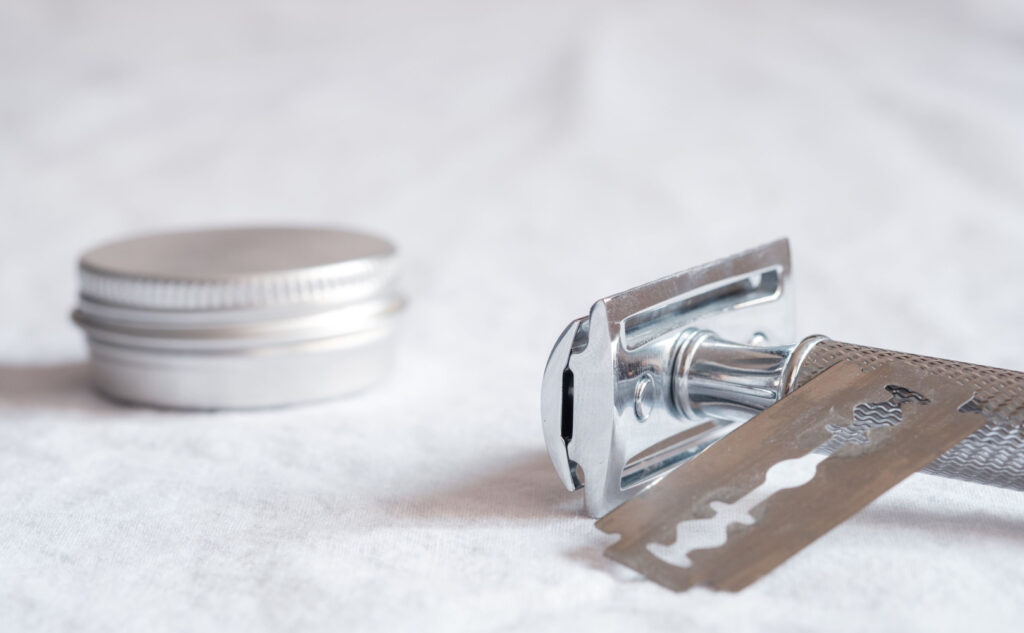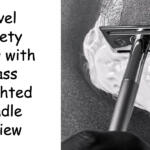
Every man’s grooming routine is a unique voyage. At its heart is the sacred art of shaving—a daily ritual that shapes not only your looks but also your self-perception. The quintessential debate in choosing the ideal grooming tool often boils down to two contestants: safety razors and straight razors.
Table Of Contents
−- Safety Razors: The Union of Elegance and Simplicity
- Straight Razors: An Ode to Traditions and Class
- The Razor Rivalry: Safety Razors vs Straight Razors
- Blade Breakdown: The Cutting Contest
- Quality of Shave: An Even Match
- Shaving Surface Area: The Long and Short of It
- Practicality: Everyday Ease or Time-Honored Ritual?
- Cleanliness: Straightforward or Complicated?
- Reducing Skin Irritation: A Soft Touch
- Safety Razors: The Highs and Lows
- Straight Razors: The Hits and Misses
- Conclusion: It’s All About Personal Preference
Having withstood the ravages of time, both contenders boast distinct advantages and present their own challenges. Allow us to escort you into the intricate labyrinth of these shaving stalwarts, enabling you to crown your champion in your grooming saga.
Safety Razors: The Union of Elegance and Simplicity
Safety razors have earned a reputation for their blend of smooth shaving and user convenience. Composed of a handle and a razor head, often split into one, two, or three components, the safety razor’s signature trait is its replaceable blades. The worn-out blades can be swapped after every shave or once they lose their edge.
The charm of a safety razor lies in the control and precision it offers during your shave, often leading it to be the go-to choice for a closer shave. Notably, safety razors are hailed for their skin-friendly nature, warding off common irritations like razor burns and bumps.
Straight Razors: An Ode to Traditions and Class

Straight razors are the enduring tools of the shaving trade, utilized by skilled barbers and home grooming enthusiasts alike. The blade of a straight razor is a single slab of metal, typically stainless steel, attached to a handle through a pivot. This ingenious design allows the blade to be unfolded and angled to achieve a flawless shave.
Straight razors are considerably longer than safety razors, granting them the capacity to cover a broader surface area per stroke. However, mastering the craft of shaving with a straight razor calls for diligent practice and deft technique. Furthermore, these razors necessitate regular sharpening and honing to maintain the blade’s sharpness and efficacy.
The Razor Rivalry: Safety Razors vs Straight Razors
The dichotomy between safety and straight razors spans further than just the blade’s structure. Here’s a comparative synopsis:
- Ease of Use: Safety razors win the laurels for their user-friendly nature and convenience. Conversely, straight razors require a measure of expertise and familiarity for optimum usage.
- Maintenance: Safety razors demand negligible upkeep, while straight razors call for routine blade maintenance.
- Aesthetic Appeal: Straight razors exude an air of elegance and refinement, echoing traditional barbering practices. On the other hand, safety razors reflect a more contemporary design ethos.
- Shaving Results: Both safety and straight razors can deliver an exceptionally close and smooth shave, often outperforming their electric or cartridge counterparts.
Blade Breakdown: The Cutting Contest
When it comes to blades, safety razors, and straight razors diverge drastically:
- Safety razors harbor a replaceable blade, facilitating effortless replacements and granting greater control over your shave.
- Straight razors sport a single, exposed blade that’s sharper but necessitates higher expertise for safe handling.
Quality of Shave: An Even Match
In terms of the quality of the shave, both safety and straight razors hold their own. Yet, if you’re reluctant to delve into traditional shaving, a safety razor might be more your speed. The protective head of a safety razor conceals the blade, significantly lowering the risk of nicks and cuts, thereby making them a safer bet than a straight razor.

Shaving Surface Area: The Long and Short of It
When it comes to covering more surface area, straight razors are the undisputed champions. Their long, exposed blade can navigate a larger area in fewer strokes compared to a safety razor. Moreover, the gap between the guard and the blade can be adjusted to alter the number of edges exposed, enabling a highly customizable shave. Hence, straight razors can offer a swift and seamless shave, albeit with a word of caution due to the exposed blade.
Practicality: Everyday Ease or Time-Honored Ritual?
For daily use, safety razors steal the show. They are engineered for simplicity, demanding minimal upkeep. Plus, the blades are typically more wallet-friendly than their straight razor counterparts, rendering them a cost-efficient choice for routine shavers.
Conversely, straight razors require more finesse and patience. Their heft and the required technique might be daunting for novices. While they are favored by professional barbers for the impeccable shave they facilitate, they might not be as practical for daily use by an average Joe.
Cleanliness: Straightforward or Complicated?
From a hygiene standpoint, straight razors emerge victorious. Their minimalist design, devoid of any intricate parts, eliminates the potential for bacterial buildup or dirt accumulation. Cleaning a straight razor is a breeze: all you need is a bit of soap and water.
On the contrary, safety razors require additional cleaning due to their multi-part structure. Therefore, if you value cleanliness in its literal sense, a straight razor might just be your perfect match.
Reducing Skin Irritation: A Soft Touch
Both safety and straight razors are highly effective tools to minimize skin irritation and achieve a close, smooth shave. Safety razors have a shorter learning curve and still provide the precision necessary for sensitive skin.
Safety Razors: The Highs and Lows
Safety razors come with their own set of advantages and drawbacks:
- Pros: The replaceable or disposable blades make them a more economical choice in the long run. They’re also safer, and a high-quality handle can last you a lifetime.
- Cons: They require a certain level of skill and precision to achieve a close shave. Mastering a safety razor might require a bit of practice.
Straight Razors: The Hits and Misses
Just like safety razors, straight razors too have their share of pros and cons:
- Pros: They provide a close and precise shave with full control over the blade angle.
- Cons: The exposed blade can pose a danger if mishandled. Routine honing and stropping are essential to maintain the blade. While they may prove cost-effective over time, they can be intimidating and require more skill than safety razors.
Conclusion: It’s All About Personal Preference
The choice between a safety razor and a straight razor ultimately rests on your personal preference. While straight razors might deliver the closest shave, safety razors are more user-friendly and affordable. They require less skill and time and are more environmentally friendly due to reduced waste.
Conversely, straight razors might provide a longer-lasting shave and could be a better match for sensitive skin. The ideal shaver for you hinges on your unique requirements and preferences, and perhaps your readiness to embrace the art of traditional shaving.
Last update on 2024-04-26 / Affiliate links / Images from Amazon Product Advertising API
Affiliate Disclosure: This post contains affiliate links, which means I may receive a small commission, at no extra cost to you, if you make a purchase using these links.

Jay Kang
Just because i'm asian does not mean I don't need shaving. I always wanted to grow a beard when I was young, now I need to shave because hair growth for me is a problem. I'm going through what every man will and has gone through before.





